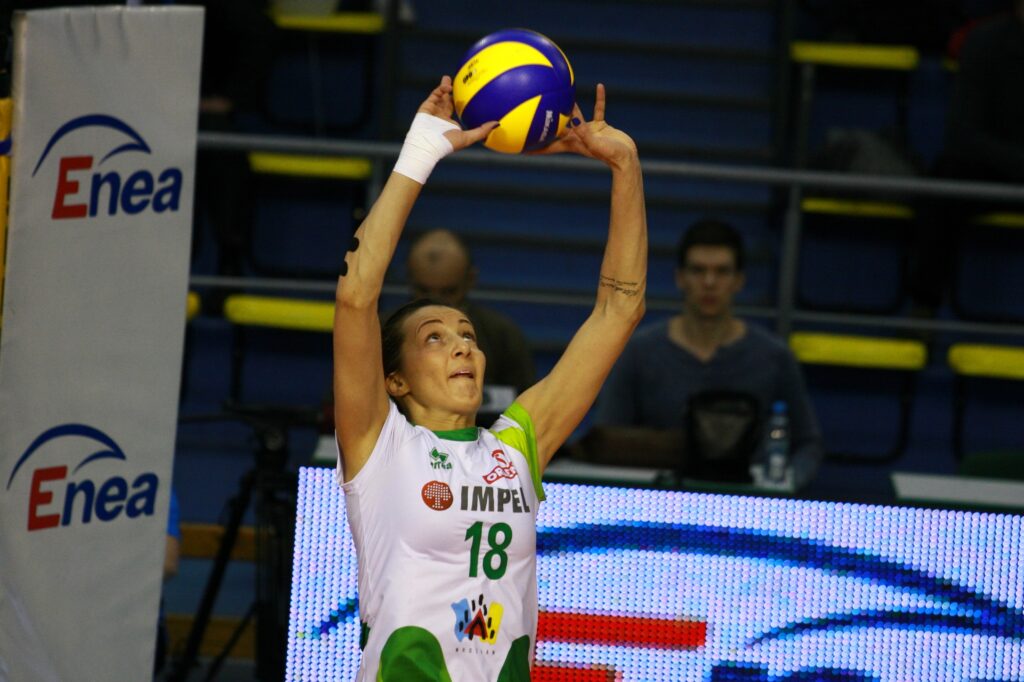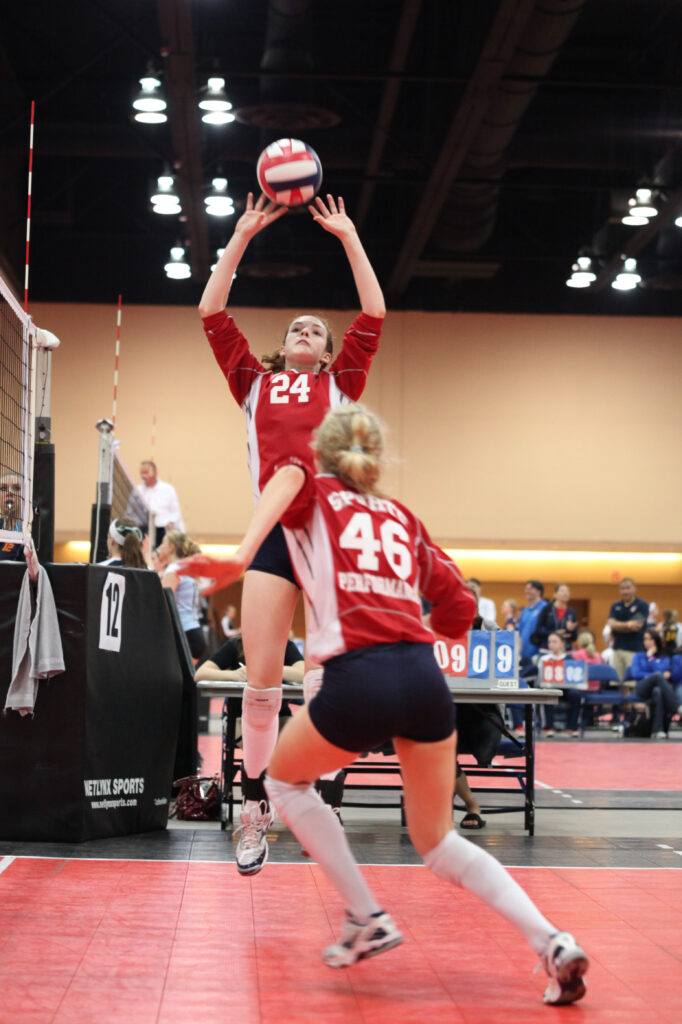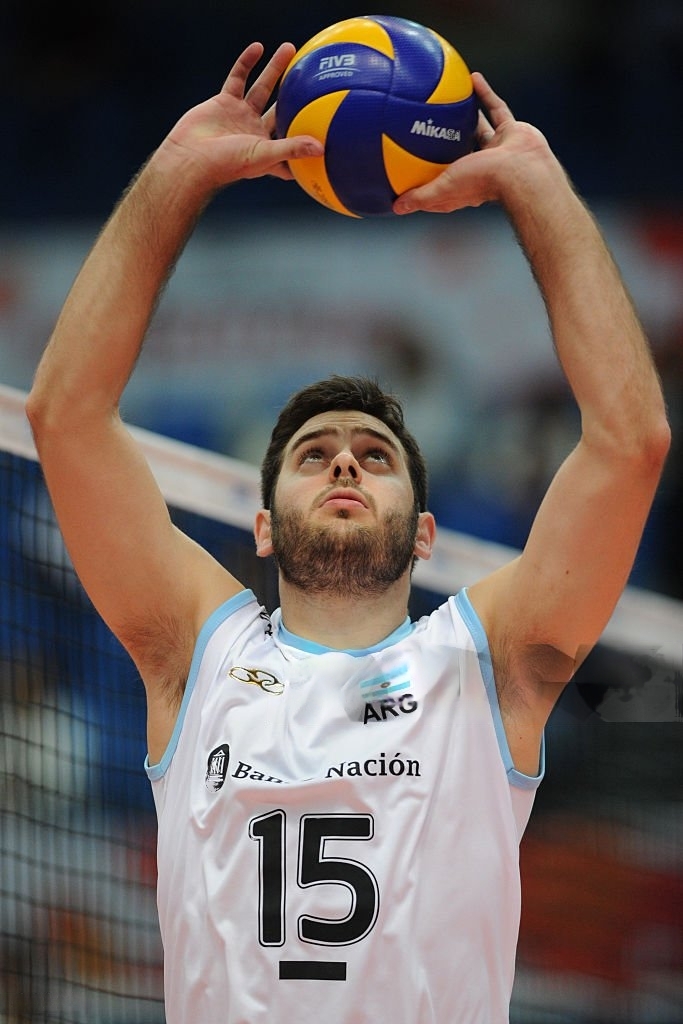Setter in Volleyball: A Definite Guide
learn, play, dominate:
your volleyball journey starts here.
The Volleyball Setter: The Conductor on the Court
The setter position in volleyball transcends simply setting the ball to a teammate. They are the orchestra director, wielding the baton to create a symphony of offensive movement. Just as a conductor leads each section of the orchestra to achieve a unified sound, the setter guides each teammate to contribute their strengths for a powerful and cohesive attack. Imagine an orchestra without a conductor – the instruments would play independently, resulting in cacophony. Likewise, a volleyball team without a skilled setter lacks direction and struggles to generate consistent offense.
So what does a setter do?
Here’s a breakdown of the key responsibilities that define the setter’s role:
Reading the Opponent’s Block
A setter’s eyes are constantly scanning the opponent’s side of the court, dissecting a complex puzzle. They analyze the positioning and movement of all blockers, with a particular focus on the middle blocker. Understanding the middle blocker’s tendencies is crucial. Are they a quick jumper known for aggressive blocks? Do they favor one side of the court when reaching for a block? This knowledge allows the setter to identify weaknesses in the block and adjust their setting strategy accordingly. By exploiting gaps or anticipating the middle blocker’s movement, the setter can set their teammates up for successful attacks.
Decision-Making Under Pressure
Split seconds separate success from failure in volleyball. The setter operates under immense pressure, constantly bombarded with information. Based on their block analysis, their teammates’ strengths and weaknesses (a powerful outside hitter might benefit from a high set or a 4 set, while a quick middle might thrive on a surprise quick set), and the overall game situation (is it a crucial point in the set or a comfortable lead?), the setter needs to make critical decisions in a heartbeat. Choosing the most effective play requires not only knowledge of various set types (high set or a 4 set, quick, slide, etc.) but also the ability to adapt to unexpected situations and exploit the opponent’s vulnerabilities.
Setting Accuracy and Consistency
Delivering the ball with pinpoint precision is paramount. The setter needs to control the height, location, and speed of the set, ensuring it reaches the hitter at the optimal point for execution. Consistency in setting goes beyond just allowing the hitter to anticipate the ball’s trajectory for a powerful spike. It empowers the hitter. A consistent set-up allows them to plan their attack more effectively. Knowing exactly where and how the ball will arrive frees the hitter to focus on their approach, jumping technique, and arm swing, ultimately leading to a wider range of offensive options. Inconsistent setting creates hesitation and disrupts the flow of the offense. By prioritizing consistent sets, the setter unlocks the full potential of their hitters and elevates the team’s offensive capabilities.
The Vocal Leader on Court
A strong setter is not just a skilled technician but also a vocal leader on the court. Their communication is the glue that binds the team’s offense. They call out plays clearly, informing teammates about the setter target (where the set is going) so everyone is on the same page. This clear communication allows for smoother transitions and quicker reactions from the hitters. Additionally, effective setters provide encouragement and maintain a positive energy throughout the game, motivating their team and fostering a sense of cohesion.
By mastering these core responsibilities, the setter becomes the central figure in the team’s offensive strategy, orchestrating plays, directing the flow of the attack, and ultimately dictating the team’s offensive success.
Mastering the Art of Setting: Technique and Fundamentals
Setting a volleyball effectively is an art form – a combination of precise technique, well-honed muscle memory, and a deep understanding of the game. This section will cover the fundamental aspects of setting, equipping you with the knowledge to not only understand the “what” but also the “how” of becoming a skilled setter.
Hand and Finger Positioning
- Imagine a Dish: Visualize creating a small dish with your hands. This provides a stable platform for receiving and controlling the ball.
- Thumbs Upward with a Slight Arch: Extend your thumbs upwards, forming a gentle arch. This arch provides support and helps maintain the pocket shape for the ball.
- Spread Fingers with Slight Forward Point: Spread your fingers slightly apart, creating a small gap between them. The fingertips should point forward with a slight upward tilt. This creates a “pocket” for the ball to rest in and allows for a gentle, controlled touch.
- Maintain Relaxed Hands: Avoid gripping the ball tightly. Instead, maintain a relaxed yet controlled posture in your hands and wrists. Tensing up can hinder your ability to cushion the ball effectively and absorb the impact upon contact. Imagine your hands as springboards, gently guiding the ball upwards with a slight push.

Contact with the Ball
- Fingertips Only: The ideal contact point is your fingertips, not your palms. This allows for a delicate touch and ensures you maintain control over the ball’s trajectory.
- Pushing Motion: Think of setting as a gentle push rather than a forceful hit. Use your fingertips to control and direct the ball upwards, focusing on generating lift and guiding it to the desired location.

Beyond the basic hand position, setting technique can be further broken down into:
Platform or Bump Setting
This is the most common setting technique, where both hands are used to create a stable platform for receiving and controlling the ball.
One-Handed Setting
The one-handed set is an advanced technique that allows a player to set the ball using just one hand. This is particularly useful in situations where a two-handed set isn’t ideal:
- Limited Space: When the ball is close to the body or near the net, there might not be enough space to bring both hands together for a traditional set. A one-handed set allows for a quicker reaction and better control in tight situations.
- Unexpected Receive: If a player receives a ball that’s high or fast, a one-handed set can be a more reliable option than attempting a two-handed set that might be fumbled. The one-handed technique allows for a quicker reaction and can still provide a decent amount of control for the setter’s teammate to spike.
Setting Variations: Orchestrating the Offense
Different set types cater to various offensive strategies. Here are some of the most common sets, along with key aspects to consider for each:
High Set (4 Set)
- Purpose: Ideal for a strong outside hitter who requires a three-step approach for a powerful spike.
- Focus Points: Set the ball high enough for the hitter to comfortably approach with three steps, ensuring the ball reaches the optimal hitting point.
Back Set
- Purpose: This set is delivered behind the setter’s head, targeting the opposite hitter for a powerful attack from the right side of the court. It’s a great option to surprise the blockers and utilize the opposite hitter’s offensive capabilities.
- Focus Points: While the hand positioning remains similar to a regular set, achieving pinpoint accuracy is crucial. Back sets are typically set faster, aiming for a second or even first tempo approach by the opposite hitter.
Slide Set (Slide)
- Purpose: A set shifted laterally towards the opposite antenna (outside of the court), aiming to deceive the blockers and create an open hitting lane for a teammate, typically the opposite hitter.
- Focus Points: Maintain proper hand positioning while shifting your body laterally during the setting motion. Ensure the set reaches the desired location outside the court, creating an offensive opportunity for the opposite hitter.
Quick Set (Quick)
- Purpose: A faster set delivered close to the net, often targeting the middle hitter for a surprise attack before the block can fully form.
- Focus Points: Set the ball with more speed and a slightly flatter trajectory compared to a high set or a 4 set. Maintain accuracy to ensure the middle hitter can reach the ball comfortably for a quick spike.
By mastering these setting techniques and variations, setters gain the flexibility to adapt their offense to different situations, exploit weaknesses in the block, and keep the opponent guessing.
Building the Ultimate Setter: Training and Development
At-Home Setter Drills
Limited resources shouldn’t hold you back! Here are some drills you can incorporate into your training routine, even without a full team or fancy equipment:
- Wall Work: This classic drill is a cornerstone of setter development. Face a wall and practice setting the ball repeatedly. Focus on proper hand positioning, fingertip control, and achieving consistent height and trajectory. As you gain confidence, experiment with different set types like high set or a 4 set and quick sets.
- For an added challenge, try incorporating a squat motion into your wall sets. Stand facing the wall with your feet shoulder-width apart. Begin setting the ball repeatedly. As you continue setting, slowly lower yourself into a squat position while maintaining good form (back straight, core engaged). Don’t pause at the bottom of the squat. Instead, continue setting the ball as you gradually stand back up to your starting position. Repeat this motion for several repetitions. This variation adds an element of core stability and leg strength training to your setting practice.
- For an added challenge, try incorporating a squat motion into your wall sets. Stand facing the wall with your feet shoulder-width apart. Begin setting the ball repeatedly. As you continue setting, slowly lower yourself into a squat position while maintaining good form (back straight, core engaged). Don’t pause at the bottom of the squat. Instead, continue setting the ball as you gradually stand back up to your starting position. Repeat this motion for several repetitions. This variation adds an element of core stability and leg strength training to your setting practice.
- Target Practice: Invest in a setter net training target to elevate your setting accuracy. Hang the target on a wall or net at an appropriate height (around 8-10 feet for beginners). Now, unleash your inner sharpshooter! Practice setting the ball consistently, aiming for the designated target zones on the net. This drill helps you visualize the ideal set location for various hitting approaches and refines your hand-eye coordination for pinpoint control.
- Parent Pitching In: Don’t have a partner? No problem! Enlist the help of a supportive parent. Ask them to stand at an appropriate distance (around 8-10 feet for beginners) and extend their arm upwards. Practice setting the ball to their outstretched arm, mimicking the height and location of a hitter’s approach. This drill allows you to refine your setting accuracy and hand positioning for various hitting scenarios. As your skills progress, your parents can gradually adjust their arm position to simulate different set types (higher for a high set or a 4 set, closer to the net for a quick set).
Mastering Hand Signals: Communication is Key
Guide for Hand Signal Mastery
Effective communication on the court is paramount for a successful volleyball team. As a setter, you are the quarterback, and clear, consistent hand signals are your playbook. Learning and utilizing a consistent set of hand signals with your hitters is crucial for smooth offense and maximizing scoring opportunities.
It’s important to note that these signals may vary depending on location and level of play
Hiding Signals from Opponents
- Setters typically use hand signals on their chest to conceal them from the opposing team.
- They might also use their shirt to hide the signals while turning towards the intended hitter.
Front Row Setter Hand Signals
Quick Sets
- One: Signal 1, with your index finger. Traditional quick set to middle blocker.
- Push One: Like a One set, but slightly off-center and push to the left. It signaled doing a “hook” with your index finger, and you can also do the “hook” motion.
- Shoot or Three: Signaled by the number 3 or a gun type motion, to imitate the “shooting” motion of the set.
- Attention: This one requires a really good understanding between setter and hitter.
- Back 1: Raise your pinkie finger. It’s a quick set but the middle blocker will hit behind the setter (between where the setter is, and where the opposite is)
High Ball Sets in the Front Row
- Two Ball (Slightly higher set in the middle): Signal by doing the number two with your index and middle finger.
- Back Two (Opposite of Two Ball): Ring finger and pinky finger extended together. Set to the opposite hitter.
- Four Ball (Traditional high ball to the left side): Four fingers extended together.
- Hut Set (Faster four ball): Signaled with a slash across your chest.
- Go Set (Even faster than Hut): Two fingers extended in a shooting motion (like a gun).
- 32 Ball/Rip Set (Shorter and quicker highball): Hand forms an arch shape.
- Five Set: Five fingers extended together. Set the ball to the opposite hitter.
- Red Ball (Faster Five Set): Fist clenched.
- Slide: Thumb and pinky finger extended together.
Back Row Setter Hand Signals
Using Your Chest as a Court
- Back-row setters use their chest and hands to signal attack locations.
- Imagine your collarbone represents the 3-meter (or 10-foot) line on the court.
- Signals on your chest indicate where the attacker will hit from the back row.
Signal Breakdown
- D-ball or Backward Right Slide Set: Draw a line outside your left chest muscle. This tells your opposite back-row hitter to attack from that area.
- Pipe Set (High Middle Set): There are two options:
- Draw a line down the middle of your chest.
- Make two fists together (like a pipe).
- A-ball (Left Side Attack): Draw a line down the outside of your right chest muscle. This instructs the left-side back-row attacker to hit from the “A” zone.
- B-ball (High Back-row Attack Between A and Pipe): Draw a line in the middle of your right chest muscle.
- C-ball (Between Pipe and D-ball): Draw a line in the middle of your left chest muscle.
- BIC or Back Row Quick Set: Make a fist and use your thumb like starting a lighter.
Level Up Your Sets with Weighted Volleyballs (Start Light!)
Weighted volleyballs can take your setting game to the next level, but it’s important to be smart about the weight you choose. Don’t grab the heaviest one right away!
Building Wrist Strength: Technique First, Weight Training Second (Especially for Beginners)
Before diving into weighted volleyballs, let’s address a common misconception: your wrists are not actually muscles. The movement of your wrist is controlled by a group of muscles in your forearm. These muscles allow for flexion (bending the hand down), extension (bending the hand back), radial deviation (moving the thumb away from the palm), ulnar deviation (moving the thumb towards the palm), and pronation/supination (rotating the forearm). The most important movement for setting is wrist flexion.
While weighted balls can strengthen your forearms, you shouldn’t rely on them solely for good setting, especially in your first year of playing. Focus on proper setting technique first. You can build wrist strength with dumbbells, cable machines, a setter ball, or even a medicine ball.
Now, back to weighted volleyballs!
Start Light and Build Strength Safely
Using a weight that’s too much for your fingers can lead to injuries. Instead, begin with a weight that lets you maintain proper form with every set. This ensures you’re building strength safely and effectively.
The Benefits of Gradually Increasing Weight
As your fingers get stronger, you can gradually bump up the weight of the ball. With each rep, your muscles work harder to control the heavier ball. This translates to better setting on the court.

Stronger Fingers, More Powerful Sets
Stronger fingers mean you can put more power into your sets. This translates to more accurate throws and a higher trajectory for your hitters to spike with power. Regularly using weighted volleyballs is a well-known way to improve the explosiveness and precision of your setting.
Strength and Conditioning
Beyond setting skills, physical fitness is essential for setters. Here are some key areas to focus on:
Core Strength
A strong core provides stability and power for consistently setting the ball. Exercises like planks, side planks, and Russian twists are excellent for core development.
Plyometrics
Jumping ability allows you to reach higher for better sets and block attempts. Plyometric exercises like box jumps and vertical jumps can significantly improve your explosiveness.

Cardio
This workout can improve your heart health and fitness in just 30 minutes, making it a great time-saving option.
Here’s what to do:
- Warm up: Get your blood flowing with a light activity like jogging or jumping jacks for 5 minutes.
- Push yourself: Sprint for 4 minutes at a very hard effort, aiming for 85-95% of your maximum heart rate. This will feel challenging!
- Recover: Take a 3-minute break to walk and bring your heart rate down.
- Repeat: Do this cycle of sprinting and recovery a total of 4 times.
How often can you do this?
You can see results with as little as one session per week! If you feel recovered, you can add more sessions, but listen to your body and take rest days when needed.
Caution: This workout is intense and not for beginners. It’s important to gradually build up your fitness before trying it. If you’re new to exercise, consult with a doctor before starting this program.
Footwork Drills
Objective
- Train footwork for each situation (tight set, coming of the net, coming of the back row, bad receives that fall in the 3-meter line, off the 3-meter line, close to the 4)
- Footwork is such a huge part of setting and something that isn’t worked on at all by most starting out. The momentum you have with your body provides a lot of the power to send the ball around the court. Get used to driving the ball off your right leg to where you’re going. We ALWAYS want to be moving into the ball on every set, but that doesn’t mean we will be.
- Your position on the court to where you will be setting will vary based on system and current rotation, but you’ll always want to get into a position where you can move towards the ball. That footwork is very specific to be perfect, but as a general rule is very forgiving.

Sharpening the Mind: Mental Training for Setters
Here’s how to strengthen your mental game and become a setter who thrives under pressure:
Become a Film Buff
Go beyond just watching professional volleyball matches. Turn yourself into a film analyst, focusing on the setters. Dissect their decision-making processes. How do they read the block? When do they choose a quick set versus a high set or a 4 set? How do they adjust their strategy based on the game situation? Pay close attention to their anticipation skills – how do they seem to know where the hitter will be before they even jump? Analyze their communication strategies as well. How do they call plays and keep their teammates informed? By actively studying elite setters, you can subconsciously absorb these skills and decision-making strategies, enhancing your own on-court presence.
Visualize Success
Visualization is a powerful mental tool. Close your eyes and picture yourself on the court. Imagine yourself in pressure situations, calmly analyzing the block, delivering pinpoint sets, and leading your team to victory. Visualize the perfect set you want to achieve, feeling the ball leave your fingertips with perfect control and accuracy. The more vivid and detailed your visualizations, the more you program your mind and body for success. This mental rehearsal can not only boost your confidence but also improve your reaction time and decision-making during actual games.
Pressure Cooker Prep
Setters are the conductors of the offense, and the weight of the game can often rest on their shoulders. Pressure situations are inevitable, but you can prepare yourself to stay calm and composed. Practice relaxation techniques like deep breathing exercises and meditation. Learning to control your breathing slows your heart rate and calms your nerves, allowing you to think clearly and make sound decisions even in the most intense rallies.
Beyond Technique: Essential Setter Skills
While mastering the setting technique is crucial, several other skills elevate a setter from competent to truly exceptional. These additional tools empower them to orchestrate the offense with strategic brilliance and composure:
Court Awareness and Anticipation
A great setter is like a chess grandmaster, several moves ahead of the game. They possess a heightened sense of court awareness, anticipating the server’s delivery, the opponent’s attack strategy (based on their positioning and body language), and even their teammates’ movements (predicting their approach for a spike). This allows them to position themselves strategically for optimal setting efficiency and react swiftly to rapidly changing game situations. Imagine a setter anticipating a back-row attack before the serve even leaves the opponent’s hand – that split-second advantage can completely disrupt the opponent’s offense and create a scoring opportunity for their own team.
Communication and Leadership
The setter is the undisputed “quarterback” on the court. Effective communication is their secret weapon. They need to be a vocal leader, clearly calling out plays and informing teammates about the designated “setter target” (where the set is going). This ensures everyone is on the same page, allowing for seamless transitions and quicker reactions from the hitters. Furthermore, maintaining positive communication throughout the game keeps the team’s energy high and fosters a sense of camaraderie, crucial for overcoming challenges and securing victory.
Adaptability
Volleyball is a dynamic chess match, with strategies constantly evolving throughout the game. A masterful setter thrives on adaptability. They can adjust their approach based on the opponent’s blocking schemes, unexpected situations like a teammate’s injury, or even a sudden shift in game strategy from their coach. They can seamlessly switch between a high set or a 4 set for a powerful outside hitter to a surprise quick set for the middle blocker, keeping the opponent guessing and exploiting weaknesses in their defense.
The Intriguing World of Setter Tactics
Beyond the basic set types, setters can utilize various advanced tactics to deceive the opponent and create scoring opportunities:
Mastering the Setter Dump
A well-timed setter dump can catch the opposing team off guard and score a quick point. Here’s how to master this deceptive move:
- The Fake Set: It all starts with deception. Jump and initiate the setting motion, as if you’re feeding the ball to a hitter. This draws the blockers up and opens space in the middle of the court.
- Dump It Down: Here’s where the surprise comes in. Instead of setting, use a two-handed push or a one-handed “shove” to send the ball softly but quickly over the net. Aim for the open area in the middle, or target a weak spot in the opponent’s defense.
- Adding Power: Don’t be fooled by the term “dump.” You can add some power to your dump for a sharper attack. Use a one-handed “spike” motion, focusing on directing the ball down with precision rather than pure force.
- One-Handed Surprise: The one-handed dump is another sneaky option. Fake the set with your dominant hand, then quickly switch and use your other hand to push the ball over. This throws off the blockers’ timing even more.
- Practice Makes Perfect: Mastering the setter dump takes practice. Work on your hand movements to develop a smooth fake set transition. Train with a teammate or against a wall to perfect your aim and control.

By incorporating the setter dump into your repertoire, you’ll keep the opposing team guessing and add another dimension to your offensive attack.
Dictating the Pace: Mastering Tempo Control in Volleyball
Volleyball is a dynamic game where controlling the tempo can be the difference between a predictable, easily defended offense and a potent, multifaceted attack. Here’s how to become a master of tempo control:
- The Power Play: Fast tempos involve setting the ball quickly after the receive pass. This puts pressure on the opposing team to react rapidly and can catch them off guard. Utilize fast sets, quick attacks, and powerful serves to dictate a fast-paced game.
- Slowing it Down: A slower tempo allows for more deliberate play. You can use a high, slow set for your outside hitter to exploit mismatches on the block. This also gives your team time to adjust their positioning and strategize against the opponent’s defense.
- Varying Your Arsenal: The key isn’t just speed. Changing the tempo throughout the game keeps the opponent guessing. Follow up a fast set with a high slow set for your opposite hitter, or surprise them with a setter dump after a slow fake set.
- Reading the Opponent: A skilled setter can analyze the opponent’s weaknesses and adjust the tempo accordingly. Is their back row struggling with a fast serve? Keep the pressure on with a quick tempo. Are their blockers slow to react? Exploit it with a deceptive slow set.
- Communication is Key: Tempo control isn’t a solo act. Clearly communicate your intentions to teammates. Let them know if you’re planning a fast set or a high slow set, allowing them to adjust their approach and positioning for optimal offensive efficiency.

By mastering tempo control, you can dictate the flow of the game, exploit weaknesses in the opposing team’s defense, and create a more unpredictable and effective offense. Remember, the best setters are the ones who can adapt their tempo based on the situation and keep the opponent constantly on their toes.
The Hall of Fame: Legendary Setters Who Shaped the Game
Volleyball boasts a rich history of phenomenal setters who have left their mark on the sport. Here are just a few examples:
- Giannelli
- De Cecco
- Micah
- Sekita (undersized example)
By studying the strategies and techniques of these legendary setters, aspiring setters can gain valuable insights and inspiration for their own development.

Conclusion: The Setter – The Engine of the Offense
The volleyball setter is more than just a player who sets the ball. They are the engine of the offense, orchestrating plays, directing the flow of the attack, and making critical decisions in the heat of the moment. Mastering the art of setting requires dedication, strategic thinking, and a deep understanding of the game.
This comprehensive guide has equipped you with the knowledge to appreciate the setter’s vital role, the intricacies of setting technique, and the various training methods to become a well-rounded setter. Remember, the journey to setter mastery is a continuous process. Embrace the challenge, hone your skills, and strive to become the engine that propels your team towards victory.